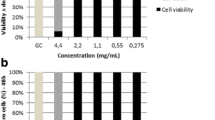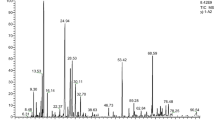Abstract
Achyrocline satureioides (Lam.) DC is a plant in the Asteraceae family that is commonly known as macela or marcela. It has antidiarrheal, antispasmodic, analgesic, anti-inflammatory and antimicrobial properties. The species Staphylococcus aureus, Pseudomonas aeruginosa and Escherichia coli are of great clinical importance, thus more evidence on the discovery of new compounds from plant species is required. The aim of this study was to evaluate the phytochemical profile and in vitro antimicrobial potential of essential oils from A. satureioides. A Minimal Inhibitory Concentration (MIC) test was performed using microdilution, and the chemical composition of the essential oil was analyzed using Gas Chromatography coupled to Mass spectrometry (GC / MS). Using the GC / MS analysis, we identified alpha-pinene and (E)-cariophilene as major phytoconstituents. We observed synergisms when the essential oil was combined with gentamicin and ampicillin against the S. aureus strain, as well as against E. coli when combined with gentamicin and norfloxacin. The results were promising, but further research is needed to assess the toxicity of A. satureioides oil and its potential for therapeutic use in humans.

Similar content being viewed by others
Abbreviations
- GC–MS:
-
Gas Chromatography coupled to Mass spectrometry
- MIC:
-
Minimal Inhibitory Concentration
- WHO:
-
World Health Organization
- HFIE:
-
Herbarium of the Integrated Spiritist Faculties
- ATCC:
-
American Type Culture Collection
- HIA:
-
Heart Infusion Agar; LMBM: Laboratório de Microbiologia e Biologia Molecular
- URCA:
-
Universidade Regional do Cariri
- CFU:
-
Colony Forming Unity
- BHI:
-
Brain Heart Infusion
References
ANVISA (2019) Norfloxacino. Farmacêutico Responsável: Dra. Tatiana de Campos CRF-SP n° 29.482. Medley Farmacêutica Ltda, Campinas – SP. Bula de remédio. Disponível em: http://www.anvisa.gov.br/datavisa/fila_bula/frmVisualizarBula.asp?pNuTransacao=1014852015&pIdAnexo=2435960. Acessado em 14 de fevereiro de 2019.
ANVISA (2012) Agência Nacional de Vigilância Sanitária. Segurança do paciente: higienização das mãos. Brasília: Ministério da Saúde. 95p.
Boscolo OH, Valle LS (2008) Plantas de uso medicinal em Quissama, Rio de Janeiro, Brasil. IHERINGIA 63(2):263–277
Brown ED, Wright GD (2016) Antibacterial drug discoveryin the resistance era. Nature 529(7586):336–343
Cechinel Filho V, Yunes R (1998) Estratégia para obtenção de compostos farmacologicamente ativos a partir de plantas medicinais. Conceitos sobre modificação estrutural para para otimização da atividade. Química Nova 21(1):99–105
Coutinho HDM et al (2015) Actividad antimicrobiana de Geraniol e Cariofileno contra Staphylococcus aureus. Revista Cubana De Plantas Medicinales 20(1):98–105
Coutinho HDM et al (2008) Enhancement of the Antibiotic Activity against a Multiresistant Escherichia coli by Mentha arvensis L. and Chlorpromazine. Chemother Karger 54:328–330
Coutinho HDM, Cordeiro LN, Bringel P (2005) Antibiotic resitance of pathogenic bacteria isolated from the population of Juazeiro do Norte - Ceará. Revista Brasileira Ciências e Saúde 9(1):127–138
Dancer SJ (2001) The problem with cephalosporins. J Antimicrob Chemother 48(4):463–478
De Sousa Eduardo L et al (2018) Antibacterial activity and time-kill kinetics of positive enantiomer of α-pinene against strains of staphylococcus aureus and escherichia coli. Curr Topics Med Chem 18(11):917–924
Fabricant DS, Farnsworth NR (2001) The value of plants used in traditional medicine for drug discovery. Environ Health 109:69–75
Farias TC, de Souza Eduardo L, Lima ZN, Benvindo S (2017) Screening antibacteriano do (+)-α -pineno frente a cepas bacterianas gram negativas. In II Congresso Brasileiro de Ciências da Saúde, p.1
IBGE - Fundação Instituto Brasileiro de Geografia e Estatística (1992) Manual técnico da vegetação brasileira. Manuais técnicos em Geociências, número 1, Rio de Janeiro, 92p
Joray MB, Del Rollán MR, Ruiz GM, Palacios SM, Carpinella MC (2011) Antibacterial activity of extracts from plants of central Argentina: isolation of an active principle from Achyrocline satureioides. Planta Med 77(1):95–100
Lawrence GHM (1951) Taxonomia das Plantas Vasculares, volume I, Fundação Galouste Gulbenkian, Lisboa, 296p
Maciel MJ, Da Silva MAS, Ethur E, Avancini CAM (2017) Indicadores fitoquímicos e atividade antibacteriana do extrato hidroalcoólico bruto de Achyrocline satureioides (“macela”) frente Salmonella spp. resistentes a antibióticos isoladas em produtos de origem animal (suínos e aves). Revista Brasileira De Higiene e Sanidade Animal 11(3):273–287
Matias EFF et al. (2013) Biological Activities and Chemical Characterization of Cordia verbenacea DC. as Tool to Validate the Ethnobiological Usage. Evidence-Based Complementary and Alternative Medicine. 2013
Moresco KS (2017) Efeitos terapêuticos de Achyrocline Satureioides (Lam.): estudos in vivo e in vitro. Tese (Doutorado em Ciências Biológicas: Bioquímica) - Universidade federal do Rio Grande do Sul, Porto Alegre
Mota FM, Carvalho HHC, Wiest JM (2011) Atividade antibacteriana in vitro de inflorescências de Achyrocline satureioides (Lam.) DC. - Asteraceae (“macela”, “marcela”) sobre agentes bacterianos de interesse em alimentos. Revista Brasileira De Plantas Medicinais 13(3):298–304
NIST Chemistry Webbook, edited by P. J. Linstrom and W. G. Mallard, http://webbook.nist.gov (acesso em novembro de 2018)
Novacosk R, Torres RSL (2006) Atividade Antimicrobiana sinérgica entre óleos essenciais de lavanda (Lavandula officinalis), Melaleuca (Melaleuca alternifolia), Cedro (Juniperus virginiana), Tomilho (Thymus vulgaris) e Cravo (Eugenia caryophyllata). Revista Analytica 35(1):36–39
Retta D, Dellacassa E, Villamil J, Suárez SA, Bandoni AL (2012) Marcela, a promising medicinal and aromatic plant from Latin America: a review. Ind Crops Prod 38(1):27–38
Sen T, Samanta SK (2015) Medicinal plants, human health and biodiversity: a broad review. Adv Biochem Eng Biotechnol 147:59–110
Silva AC, Rivas da et al (2012) Biological activities of a-pinene and β-pinene enantiomers. Molecules 17(6):6305–6316
Stoppa MA et al (2009) Estudo comparativo entre as metodologias preconizadas pelo CLSI e pelo EUCAST para avaliação da atividade antifúngica. Quím Nova 32:498–502
Vendruscolo GS, Rates SMK, Mentz LA (2005) Dados químicos e farmacológicos sobre plantas utilizadas como medicinais pela Comunidade do bairro Ponta Grossa, Porto Alegre, Rio Grande do Sul. Rev Bras 15(4):360–372
Wasick R (1963) Uma modificação do aparelho de clevenger para extração de óleos essenciais. R. Faculd. de Farm. e Bioquím., São Paulo. 1 (1): 77–81
Wiley Registry of Mass Spectral Data (1994) 6th edn. Wiley Interscience, New York
Author information
Authors and Affiliations
Corresponding author
Ethics declarations
Conflict of interest
The authors declare that they have no conflict of interest.
Additional information
Publisher's Note
Springer Nature remains neutral with regard to jurisdictional claims in published maps and institutional affiliations.
Rights and permissions
About this article
Cite this article
Gondim, C.N.F.L., Carneiro, J.N.P., Leite, C.P. et al. GC-MS-FID characterization and antibacterial activity of the essential oil from Achyrocline satureioides (Lam) DC. J. Plant Biochem. Biotechnol. 31, 394–398 (2022). https://doi.org/10.1007/s13562-021-00691-z
Received:
Accepted:
Published:
Issue Date:
DOI: https://doi.org/10.1007/s13562-021-00691-z




